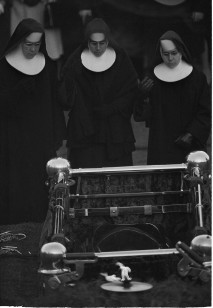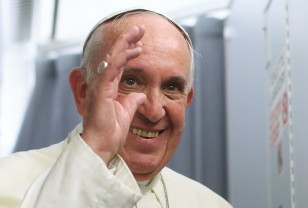Posted September 24th, 2015 at 3:36 pm (UTC-4)
By Catherine Maddux
Being a practicing Catholic is never easy.
And for me, who was raised Catholic along with my four brothers and sisters, I never found the key ingredient that makes adopting such a religious faith possible: connection.
But for the first time in my life, I have felt the possibility of it in Pope Francis. And I suspect that is true for a great many baptized and indoctrinated — but most definitely fallen — Catholics.

President Barack Obama (C) and First lady Michelle Obama (R) welcome Pope Francis at Joint Base Andrews, Maryland for the pontiff’s first visit to the United States on Sept. 22, 2015.
The Catholic Church I was introduced to during my youth in the 1970s was replete with unyielding rules that were hard for a kid to follow. And they were grounded in and governed by fear, not the love of Christ we so often heard about.
Take the process of confirmation, which prepares a Catholic to participate in Communion during Mass (that’s the wafer and wine consumed by the faithful, symbolizing “communion” with the body of blood of Jesus Christ).
First, there is learning the catechism, that is, being formally educated in church doctrine. What follows is a long “dress rehearsal” for confirmation that includes learning the rules of confession, the choreography of communion and being given a confirmation name.

Three Roman Catholic nuns pay their final respects at the grave of President John F. Kennedy at Arlington National Cemetery, Nov. 25, 1963. (AP)
The nuns who taught us were downright scary.
They stood out like a neon sign in their long black habits, faces made more severe by the tightly worn headpieces that hid all their hair and anything that remotely resembled the average human being. And they seemed mean. They were quiet, unfriendly, stern and imperious. To make matter worse, they appeared to float — not walk — along the cold linoleum floors at St. James Catholic school in Falls Church, Virginia.
Mass was held in a dark church that smelled like a putrid mix of incense and mildewed wood. And, oh, the rituals of worship, which were nearly impossible to follow: genuflect before entering the hard wooden pews. Kneel now (it hurt my nine year-old knees!), stand now! And don’t forget to sit during this passage.
For some of us, the harshness of the Church had the effect of inciting rebellion — and even scorn and mean-spirited jokes about the nuns (The priests were off limits. That would be like insulting God himself – an irreversible ticket to Hell). According to Maddux family legend, my eldest brother, who was born feisty, cursed out our school’s Mother Superior, resulting in immediate suspension.
And so it went. No connection. No uplifting spiritual moments. I just didn’t get it. And true to Catholic culture, I believed it had to be MY fault. I wasn’t trying hard enough. I was a heathen.
Even later, as a young student at The Catholic University of America, where I studied to be an actress (while fulfilling my Father’s wishes to finally become an obedient Catholic), I tried again to “get it,” but never did. I remember feeling I was missing something. My artsy friends told me the Catholic Church was a hypocritical joke and urged me to stop wasting my intellectual energy.

Pope Francis conducts Mass outside the Basilica of the National Shrine of the Immaculate Conception on Sept. 23, 2015, in Washington. (AP)
But this week, something has shifted. And I don’t think it’s just being an older, more mature woman.
It’s Francis.
It’s his kindly face. It’s the unmistakable delight in his eyes as he works a large crowd. It’s how his mouth curls up when he smiles that most authentic of smiles.
It’s the bravery of his message, delivered in a soft and gentle, but no less compelling, voice.

Pope Francis smiles on the papal plane during his return to Rome from Paraguay, July 12, 2015. (Reuters)
If the guiding principle of Catholic faith is ultimately about the love of Christ, then Pope Francis has created the space for me to consider that maybe the Catholic Church is much more than hard to follow rules, fear of sin and Hell and, worse still, the endless ugly scandals of sexual abuse of children at the hands of priests.
There is no danger of me becoming a practicing Catholic.
That said, I am deeply moved by this pope. He has brought a tear or two to my eyes this week, because there is something about this man that embodies compassion and — dare I say it — love.
Maybe his gift to me — and perhaps the world — is that he has inspired me to be a better person.
Being Catholic
By Catherine Maddux
Being a practicing Catholic is never easy.
And for me, who was raised Catholic along with my four brothers and sisters, I never found the key ingredient that makes adopting such a religious faith possible: connection.
But for the first time in my life, I have felt the possibility of it in Pope Francis. And I suspect that is true for a great many baptized and indoctrinated — but most definitely fallen — Catholics.
President Barack Obama (C) and First lady Michelle Obama (R) welcome Pope Francis at Joint Base Andrews, Maryland for the pontiff’s first visit to the United States on Sept. 22, 2015.
The Catholic Church I was introduced to during my youth in the 1970s was replete with unyielding rules that were hard for a kid to follow. And they were grounded in and governed by fear, not the love of Christ we so often heard about.
Take the process of confirmation, which prepares a Catholic to participate in Communion during Mass (that’s the wafer and wine consumed by the faithful, symbolizing “communion” with the body of blood of Jesus Christ).
First, there is learning the catechism, that is, being formally educated in church doctrine. What follows is a long “dress rehearsal” for confirmation that includes learning the rules of confession, the choreography of communion and being given a confirmation name.
Three Roman Catholic nuns pay their final respects at the grave of President John F. Kennedy at Arlington National Cemetery, Nov. 25, 1963. (AP)
The nuns who taught us were downright scary.
They stood out like a neon sign in their long black habits, faces made more severe by the tightly worn headpieces that hid all their hair and anything that remotely resembled the average human being. And they seemed mean. They were quiet, unfriendly, stern and imperious. To make matter worse, they appeared to float — not walk — along the cold linoleum floors at St. James Catholic school in Falls Church, Virginia.
Mass was held in a dark church that smelled like a putrid mix of incense and mildewed wood. And, oh, the rituals of worship, which were nearly impossible to follow: genuflect before entering the hard wooden pews. Kneel now (it hurt my nine year-old knees!), stand now! And don’t forget to sit during this passage.
For some of us, the harshness of the Church had the effect of inciting rebellion — and even scorn and mean-spirited jokes about the nuns (The priests were off limits. That would be like insulting God himself – an irreversible ticket to Hell). According to Maddux family legend, my eldest brother, who was born feisty, cursed out our school’s Mother Superior, resulting in immediate suspension.
And so it went. No connection. No uplifting spiritual moments. I just didn’t get it. And true to Catholic culture, I believed it had to be MY fault. I wasn’t trying hard enough. I was a heathen.
Even later, as a young student at The Catholic University of America, where I studied to be an actress (while fulfilling my Father’s wishes to finally become an obedient Catholic), I tried again to “get it,” but never did. I remember feeling I was missing something. My artsy friends told me the Catholic Church was a hypocritical joke and urged me to stop wasting my intellectual energy.
Pope Francis conducts Mass outside the Basilica of the National Shrine of the Immaculate Conception on Sept. 23, 2015, in Washington. (AP)
But this week, something has shifted. And I don’t think it’s just being an older, more mature woman.
It’s Francis.
It’s his kindly face. It’s the unmistakable delight in his eyes as he works a large crowd. It’s how his mouth curls up when he smiles that most authentic of smiles.
It’s the bravery of his message, delivered in a soft and gentle, but no less compelling, voice.
Pope Francis smiles on the papal plane during his return to Rome from Paraguay, July 12, 2015. (Reuters)
If the guiding principle of Catholic faith is ultimately about the love of Christ, then Pope Francis has created the space for me to consider that maybe the Catholic Church is much more than hard to follow rules, fear of sin and Hell and, worse still, the endless ugly scandals of sexual abuse of children at the hands of priests.
There is no danger of me becoming a practicing Catholic.
That said, I am deeply moved by this pope. He has brought a tear or two to my eyes this week, because there is something about this man that embodies compassion and — dare I say it — love.
Maybe his gift to me — and perhaps the world — is that he has inspired me to be a better person.